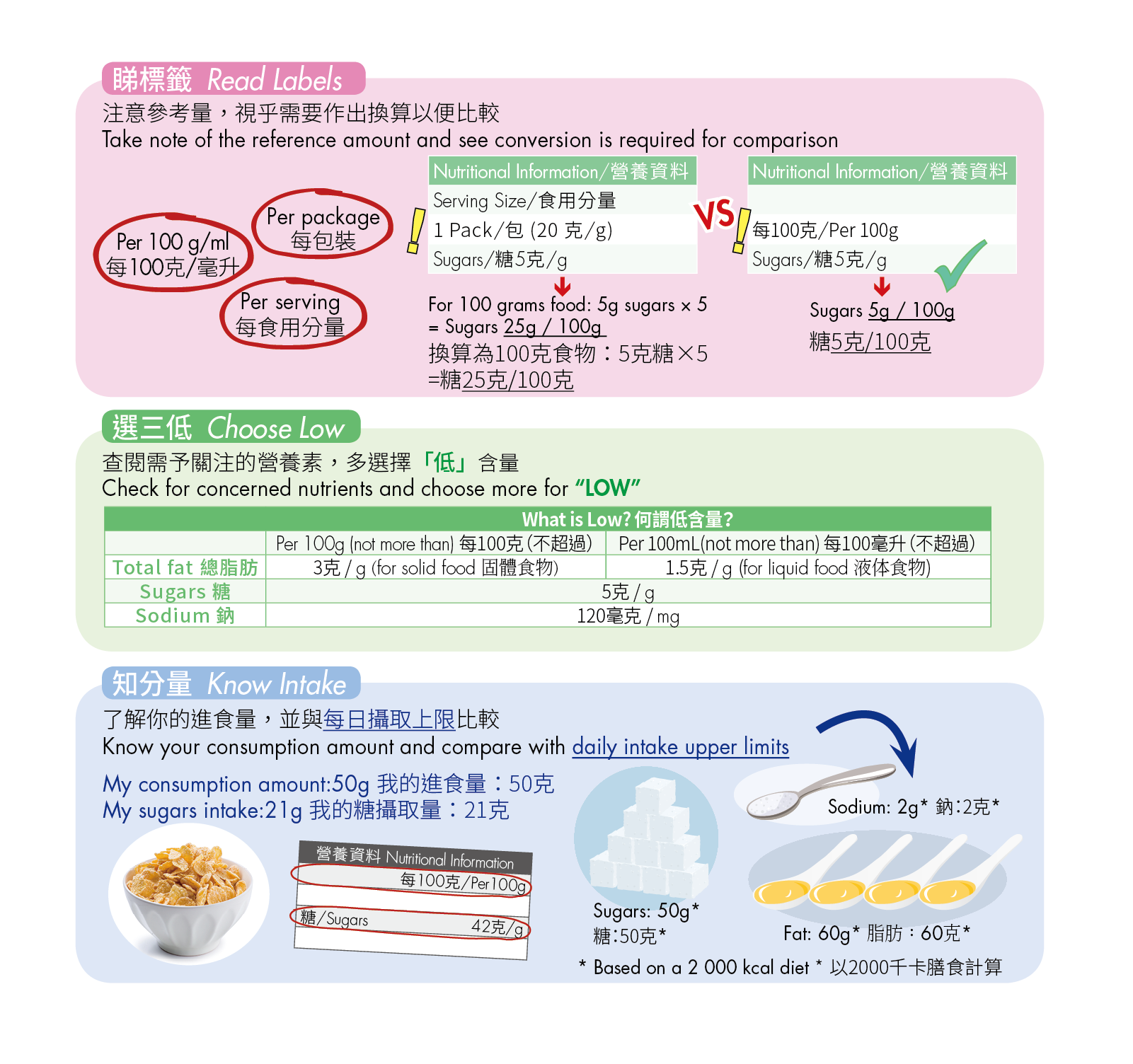
Food Safety Focus (146th Issue, September 2018) – Food Safety Platform
Read Nutrition Labels for Preventing Diabetes/Childhood Obesity
Reported by Ms Amy Leung, Dietitian,
Risk Assessment Section,
and Dr Ken CHONG, Scientific Officer,
Risk Communication Section,
Centre for Food Safety
Healthy eating can help us prevent different types of non-communicable diseases (NCD)s. Nutrition labels on prepackaged foods are a tool that helps us in achieving healthy eating. In this article, we will talk about diabetes and childhood obesity as well as preventing these conditions by referring to nutrition labels for healthy eating.
Childhood Obesity
The fundamental cause of childhood overweight and obesity is excessive energy consumed. Excessive energy intake can be resulted from eating too much food, often include sugary and fatty foods. Overweight and obese children are more likely to stay obese into adulthood and to develop chronic diseases such as diabetes, hypertension and heart diseases at a younger age.
Diabetes
Diabetes is a metabolic disorder and obesity is one of the risk factors. People with diabetes have either insulin deficiency or resistance to insulin, a hormone produced by the pancreas. As a result, it affects the use of glucose in their bodies. Uncontrolled diabetes can lead to severe complications, such as heart diseases, renal failure and stroke. Excessive fat and sodium intakes may make these complications even worse.

Read Labels for Healthier Choice
Use of Nutrition Labelling
Weight control is needed for obese children while it is also required for adults to prevent diabetes. Examining energy content of food can provide a quick reference that is important for weight control. Energy requirement varies among individuals and is affected by a number of factors such as age, gender and physical activity level, etc. For example, a 14-to 17-year old female with light level of physical activity needs around 2000 kcal a day. On the other hand, choosing a “3 Low” (i.e. low fat, low sodium (or salt), low sugars) diet is also important for obese children as well as people with diabetes. They can start the habit of reading nutrition labels by focusing on nutrients of concern in relation to their health status.
Read Labels
When comparing products using nutrition labels, comparison should be made basing on the same reference amount e.g. per 100 grams (See figure). Based on the same reference amount of food, people can make comparison among the contents of total fat, sodium and sugars of various products. Then choose the one that is lower in the three nutrients.
Choose Low
Using the reference of 100 grams of food, there are specific limits for claiming the nutrient content as low (See figure). It is better to choose more often the foods that are “Low” in total fat, sodium and sugars when comparing products.
Know Intake
On the other hand, people should also be aware of the actual amount of food that is consumed. If one eats twice the serving size, the energy and nutrient content will be doubled accordingly. Nutrition labels can be used to calculate the amount of energy and nutrients people get from food, and compare with daily intake limits accordingly. For the corn flakes example in the figure, people may be concerned about their sugars intake, i.e. they can refer to nutrition labels on sugar content from the corn flakes. The intake amount for sugars can then be calculated and compared with our daily intake upper limits. Assuming one has consumed 50 grams, the intake amount of sugars is 21 grams. Comparing with the daily intake upper limit for sugars, i.e. 50 grams based on a 2 000 kcal diet, consuming the corn flakes contributes to around 40% of daily upper limit for sugars. For total fat and sodium, similar calculation for comparing with the daily upper limits can be done.
Sodium has not been talked much in this article, but excessive sodium intake is related to hypertension and coronary heart disease. These NCDs will be addressed in the next issue.


